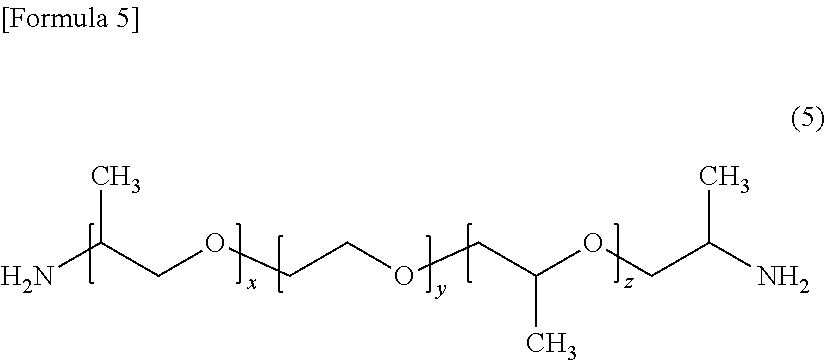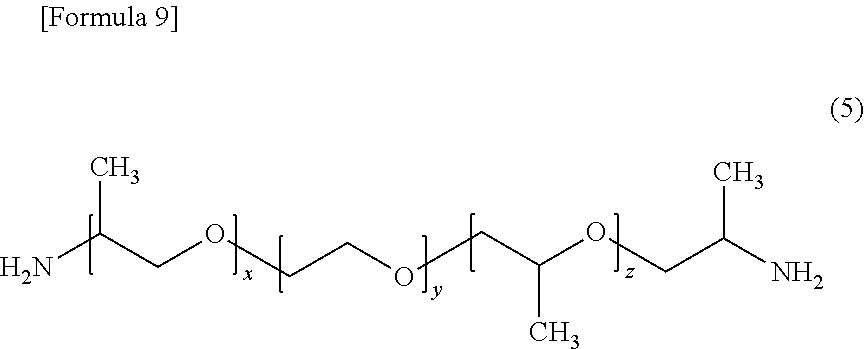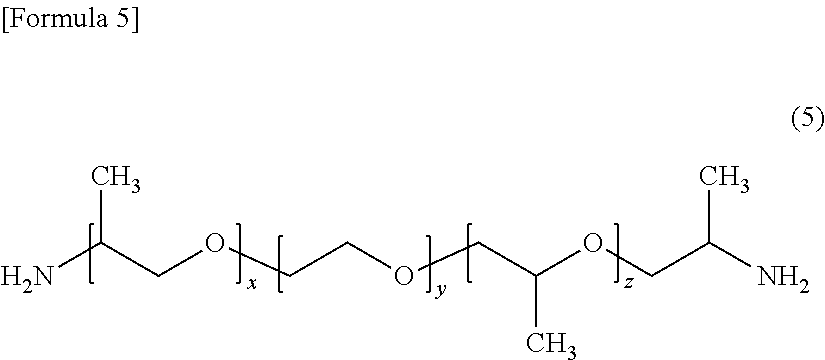Polyamide elastomer, medical device, and method for producing polyamide elastomer
a technology of polyether and polyether, which is applied in the direction of balloon catheter, catheter, etc., can solve the problems of partial thermal cracking of the polymerization product, insufficient mechanical strength of the polyether having an alkylene group containing 3 or more carbon atoms, and long polymerization time, etc., to achieve excellent dynamical properties, excellent extrusion moldability, excellent effect of moldability
- Summary
- Abstract
- Description
- Claims
- Application Information
AI Technical Summary
Benefits of technology
Problems solved by technology
Method used
Image
Examples
example 1
[0104]To a 3-L reaction vessel equipped with a stirrer, a temperature controller, a pressure gauge, a nitrogen gas inlet, and a condensation water outlet, 1200 g of 12-aminododecanoic acid and 0.6 g of hypophosphorous acid were fed. The interior of the reaction vessel was sufficiently replaced with nitrogen. The temperature was raised to and kept at 280° C. for 1 hour for melting. Then, polymerization was allowed to proceed until the number average molecular weight reached 4100. Thus, a component (a) was obtained, which was to be used as a hard segment.
[0105]To the resultant, 43.8 g (0.30 mol) of adipic acid as a component (b) was added the amount of which was equivalent to the number of moles of the terminal amine groups contained in the hard segment. Reaction was allowed to proceed at 220° C. for 1 hour for dicarboxylation of the hard segment (step (i)).
[0106]Thereto, 180 g (0.300 mol) of a polyether diamine (Jeffamine ED600 manufactured by Huntsman; having a value of (x+z) in for...
example 2
[0109]To a 3-L reaction vessel equipped with a stirrer, a temperature controller, a pressure gauge, a nitrogen gas inlet, and a condensation water outlet, 1200 g of 12-aminododecanoic acid and 0.6 g of hypophosphorous acid were fed. The interior of the reaction vessel was sufficiently replaced with nitrogen. The temperature was raised to and kept at 280° C. for 1 hour for melting. Then, polymerization was allowed to proceed until the number average molecular weight reached 6800. Thus, a component (a) was obtained, which was to be used as a hard segment.
[0110]To the resultant, 25 g (0.17 mol) of adipic acid as a component (b) was added the amount of which was equivalent to the number of moles of the terminal amine groups contained in the hard segment. Reaction was allowed to proceed at 220° C. for 1 hour for dicarboxylation of the hard segment (step (i)).
[0111]Thereto, 103 g (0.172 mol) of a polyether diamine (Jeffamine ED600 manufactured by Huntsman) as a component (c1) was added, t...
example 3
[0114]To a 3-L reaction vessel equipped with a stirrer, a temperature controller, a pressure gauge, a nitrogen gas inlet, and a condensation water outlet, 1200 g of 12-aminododecanoic acid and 0.6 g of hypophosphorous acid were fed. The interior of the reaction vessel was sufficiently replaced with nitrogen. The temperature was raised to and kept at 280° C. for 1 hour for melting. Then, polymerization was allowed to proceed until the number average molecular weight reached 9900. Thus, a component (a) was obtained, which was to be used as a hard segment.
[0115]To the resultant, 17.5 g (0.12 mol) of adipic acid as a component (b) was added the amount of which was equivalent to the number of moles of the terminal amine groups contained in the hard segment. Reaction was allowed to proceed at 220° C. for 1 hour for dicarboxylation of the hard segment (step (i)).
[0116]Thereto, 72 g (0.117 mol) of a polyether diamine (Jeffamine ED600 manufactured by Huntsman) as a component (c1) was added, ...
PUM
| Property | Measurement | Unit |
|---|---|---|
| elongation at break | aaaaa | aaaaa |
| molar ratio | aaaaa | aaaaa |
| moldability | aaaaa | aaaaa |
Abstract
Description
Claims
Application Information
 Login to View More
Login to View More - R&D
- Intellectual Property
- Life Sciences
- Materials
- Tech Scout
- Unparalleled Data Quality
- Higher Quality Content
- 60% Fewer Hallucinations
Browse by: Latest US Patents, China's latest patents, Technical Efficacy Thesaurus, Application Domain, Technology Topic, Popular Technical Reports.
© 2025 PatSnap. All rights reserved.Legal|Privacy policy|Modern Slavery Act Transparency Statement|Sitemap|About US| Contact US: help@patsnap.com



